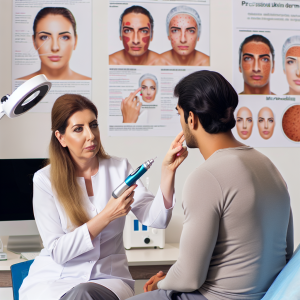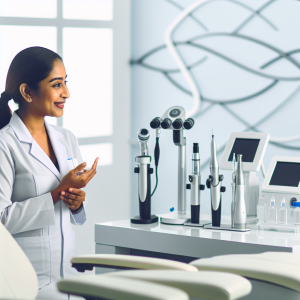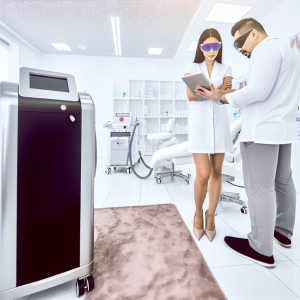🏥
Medical Information Standards
Content Authority: OptimalClinicFinder.com is a comprehensive medical directory platform connecting patients with qualified Microneedling providers. Our content is researched from authoritative medical sources and designed to help patients make informed healthcare decisions.
How Microneedling Works: Clinical Mechanism and Collagen Induction
Microneedling operates through a precisely controlled wound healing response that stimulates the body’s natural regenerative processes. When sterile, fine-gauge needles create micro-channels in the skin at depths ranging from 0.5mm to 3.0mm, the controlled injury triggers a cascade of healing mechanisms including platelet activation, growth factor release, and fibroblast proliferation. This biological response leads to increased collagen and elastin production, improved cellular turnover, and enhanced skin structure.
The treatment’s effectiveness stems from its ability to bypass the skin’s protective barrier while minimizing actual tissue damage. The micro-channels close within hours, but the healing response continues for weeks, gradually improving skin texture, reducing fine lines, and minimizing scarring. Professional devices deliver consistent needle penetration and can be adjusted for different skin areas and treatment goals, ensuring optimal results while maintaining safety protocols.
💡
Did You Know?
Clinical studies show that Microneedling patients achieve excellent results when combined with professional-grade aftercare products.
Clinical Research and Evidence Base
Extensive clinical research supports microneedling’s efficacy across multiple skin conditions. Landmark studies published in dermatology journals demonstrate significant improvements in acne scarring, with 80-90% of patients showing measurable improvement after a series of treatments. Research on anti-aging applications shows increased collagen density of 206% and elastin levels of 300% six months post-treatment.
Comparative studies reveal microneedling’s advantages over other treatments, including fewer side effects than chemical peels, deeper collagen stimulation than topical treatments, and more affordable maintenance than laser procedures. Multi-center trials involving diverse skin types confirm the treatment’s safety and effectiveness across different ethnicities and ages, with minimal risk of post-inflammatory hyperpigmentation in darker skin tones.
Treatment Protocols and Clinical Management
Professional microneedling follows standardized protocols that ensure safety and optimize results. The treatment process begins with thorough skin cleansing and application of topical anesthetic to minimize discomfort. Providers select appropriate needle depth based on skin thickness, treatment goals, and patient tolerance, typically using 0.5-1.5mm for facial treatments and up to 3.0mm for acne scarring.
The actual procedure involves systematic coverage of the treatment area with overlapping passes in multiple directions to ensure uniform collagen stimulation. Professional devices maintain consistent speed and pressure while built-in safety features prevent excessive tissue damage. Treatment duration ranges from 15-45 minutes depending on area size, followed by application of healing serums and post-treatment skincare protocols that support optimal recovery and results.
💡
Quick Tip
Microneedling works best when combined with healthy lifestyle choices for optimal results.
Safety Profile and Risk Management
Microneedling boasts an excellent safety profile when performed by qualified professionals using sterile technique and appropriate protocols. Common immediate side effects include mild erythema (redness), slight swelling, and temporary skin sensitivity, which typically resolve within 24-72 hours. These responses are normal indicators of the treatment’s effectiveness and the skin’s natural healing process.
Rare complications include infection, scarring, or post-inflammatory hyperpigmentation, occurring in less than 1% of professional treatments. Risk factors for complications include active skin infections, certain medications, recent sun exposure, and improper aftercare. Qualified providers minimize risks through thorough patient screening, sterile protocols, appropriate device settings, and comprehensive aftercare education including sun protection and gentle skincare practices.
Cost Analysis and Treatment Investment
Microneedling represents a cost-effective approach to skin rejuvenation compared to more aggressive procedures. Individual session costs range from $200-$700 depending on geographic location, provider expertise, and treatment complexity. Most patients require 3-6 sessions spaced 4-6 weeks apart for optimal results, with annual maintenance treatments to sustain benefits.
⚠️
Safety First
Always consult a qualified medical professional before starting Microneedling. Results vary by individual.
When comparing costs to alternatives, microneedling offers excellent value. Laser resurfacing can cost $2,000-$5,000 per treatment with longer recovery times, while surgical procedures require significantly higher investments with associated risks. Many practices offer package pricing for multiple sessions, and some providers include complementary treatments or skincare products to enhance results and provide additional value.
Finding Qualified Microneedling Providers Near You
Selecting the right provider is crucial for safe, effective microneedling treatments. Ideal practitioners include board-certified dermatologists, plastic surgeons, or certified aesthetic professionals with specific microneedling training and experience. Look for providers who use FDA-cleared devices, maintain sterile protocols, and offer comprehensive consultations including skin analysis and treatment planning.
✓
Why Choose Microneedling?
●
Clinically proven
●
FDA approved
●
Minimal downtime
●
Long-lasting
When researching providers, verify credentials through state medical boards and professional organizations. Quality practices will readily discuss their experience, show before-and-after photos, explain their protocols, and provide detailed information about expected results and potential risks. Avoid providers offering unusually low prices or making unrealistic promises, as these may indicate compromised safety standards or inexperience with professional techniques.
Maximizing Treatment Outcomes and Long-term Benefits
Successful microneedling requires proper preparation, professional treatment, and diligent aftercare. Pre-treatment preparation includes avoiding sun exposure, discontinuing certain medications or skincare products, and maintaining healthy skin through proper cleansing and moisturizing. Following provider instructions ensures optimal skin condition for treatment and minimizes complication risks.
Post-treatment care significantly impacts results and recovery time. Essential aftercare includes gentle cleansing, avoiding sun exposure, using recommended healing products, and following activity restrictions. Many providers enhance results by combining microneedling with complementary treatments like platelet-rich plasma (PRP), vitamin serums, or radiofrequency energy, creating comprehensive rejuvenation protocols tailored to individual needs and goals.
📚 Medical Authorities & Professional Standards
All Microneedling procedures should be performed by licensed medical professionals following established clinical guidelines and safety protocols.
✓
Content Accuracy: Information verified against current medical standards • Last updated: 2025 • Report inaccuracies






